Table of Contents
Home / Blog / AI/ML
Demystifying GANs: A Deep Dive into Generative Adversarial Networks
July 4, 2024

July 4, 2024
Generative Adversarial Networks (GANs) have become one of the most groundbreaking advancements in artificial intelligence since their introduction in 2014 by Ian Goodfellow and his team. These networks have revolutionized various aspects of machine learning, particularly in generating synthetic data that is remarkably similar to real-world data. GANs have gained significant traction due to their unique ability to create high-quality images, videos, and other types of data, which has a wide array of applications.
According to a report by Allied Market Research, the global GAN market size was valued at $118 million in 2019 and is projected to reach $2.15 billion by 2027, growing at a CAGR of 34.4% from 2020 to 2027. This exponential growth underscores the increasing importance and application of GANs across different sectors.
Following this, the transformative power of GANs extends beyond just data generation; they play a crucial role in enhancing video game graphics, improving medical imaging, augmenting data for training machine learning models, and much more.
This blog aims to provide a comprehensive overview of GANs, from their basic architecture and training process to the challenges they present, their various types, real-world applications, and future directions. By understanding these aspects, we can better appreciate the profound impact GANs have on the AI landscape and their potential to revamp numerous industries.
What are Generative Adversarial Networks GANs? A Journey Through History
The concept of GANs emerged in a landmark paper by Ian J. Goodfellow et al. in 2014 [1]. While the idea was novel, it built upon several key advancements in deep learning, particularly the success of deep convolutional neural networks (CNNs) for image recognition.
The foundational idea of GANs is simple yet brilliant: create two competing neural networks – a generator and a discriminator. The generator strives to create realistic data samples, like images or text, that are indistinguishable from real-world data. On the other hand, the discriminator acts as a critic, aiming to correctly identify whether a given sample is real or generated. Through this ongoing contest, the generator constantly learns from its failures, improving its ability to produce realistic outputs.
Here’s a historical timeline outlining some key milestones in the development of GANs:
- 2014: Introduction of the Generative Adversarial Networks concept by Ian J. Goodfellow et al. [1].
- 2016: Development of Deep Convolutional GANs (DCGANs) by Alec Radford et al., which significantly improved the quality of generated images [2].
- 2017: Introduction of Wasserstein GANs (WGANs) by Martin Arjovsky et al., addressing stability issues faced during training [3].
- 2019: Introduction of StyleGAN by NVIDIA, capable of generating incredibly realistic and diverse images of faces [4].
These advancements showcase the rapid evolution of GANs and their growing capabilities in various domains.
Understanding the Generative Adversarial Network Architecture
The architecture of a Generative Adversarial Network (GAN) consists of two main components: the Generator and the Discriminator. These components are trained in a competitive, adversarial manner. The Generator’s role is to create new samples that closely resemble the training data, while the Discriminator’s task is to differentiate between these generated samples and the actual training data. Let’s delve into the specifics of each component.
- Generator Architecture
The Generator starts with random noise as input and produces synthetic samples designed to mimic real training data. Typically composed of one or more deep neural networks, the Generator often utilizes convolutional layers for image generation or recurrent layers for sequential data generation. The samples generated by the Generator are then evaluated by the Discriminator, which learns to distinguish between the synthetic and real samples.
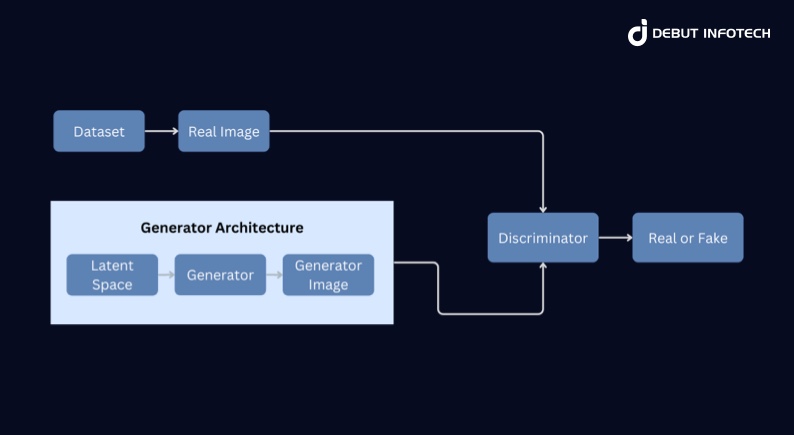
Understanding the Generator is critical to grasping the GAN training process. The Generator’s architecture includes three main components: the latent space, the generator itself, and the image generation section. It samples from the latent space, establishing a relationship between this space and the output. Essentially, a neural network maps inputs from the latent space to outputs, such as images.
During adversarial training, the Generator and Discriminator are linked in a model where the Generator aims to produce images indistinguishable from real ones. The goal is for the Generator to output images that, after the entire training process, appear real. Training GANs involves focusing on the Generator, with the Discriminator often pre-trained for several epochs before full training begins.
class Generator:
def __init__(self):
self.initVariable = 1
def lossFunction(self):
return
def buildModel(self):
return
def trainModel(self, inputX, inputY):
return
The Generator is defined within a class structure comprising three primary functions: the class template, the loss function, and the buildModel function. The loss function specifies how to train the model, if necessary, and the buildModel function constructs the neural network model. Specific training sequences for the model are included within this class, though the internal training methods are primarily used for the Discriminator.
- Discriminator Architecture
The Discriminator in a GAN is a deep neural network that evaluates whether images are real or fake, producing a scalar value between 0 and 1 to indicate the probability of the input being real. It is trained as a binary classifier, aiming to minimize the binary cross-entropy loss between its predictions and the true labels. The Discriminator’s architecture typically involves a Convolutional Neural Network (CNN) and is trained on both real and generated datasets to maintain a balanced training process with the Generator.
As a vital component of the GAN architecture, the Discriminator functions as an adaptive loss function, learning and adapting to the underlying data distribution rather than using heuristic techniques. It assesses the authenticity of both real and generated images, gradually improving its ability to distinguish between them. This process allows the Generator to produce new, unseen data from the latent space. The Generator is trained to minimize the log loss of the Discriminator’s output for generated samples, aiming to produce realistic images and minimize the differences between generated and real data.
The GAN training process involves iteratively training the Generator and Discriminator in an adversarial manner until they reach a point of convergence. This iterative process enables the GAN to generate new data that closely resembles the training data.
Optimizing Generator and Discriminator Training
Understanding how GANs are trained is crucial. Let’s take a step-by-step look at this adversarial training process:
1. Initialization: The generator and discriminator networks are initialized with random weights and biases.
2. Training the Discriminator:
- A batch of real data samples is fed to the discriminator.
- The discriminator analyzes these samples and outputs a high probability score (close to 1) for them, signifying real data.
- Next, a batch of samples generated by the current version of the generator is fed to the discriminator.
- The discriminator attempts to identify these generated samples and outputs a low probability score (close to 0) for them.
3. Training the Generator:
- Based on the feedback received from the discriminator (its loss function), the generator updates its weights and biases to improve its ability to generate realistic data that can fool the discriminator.
Loss Functions: Both the generator and discriminator have their loss functions that guide their improvement. The generator loss measures how well the generated samples fool the discriminator, while the discriminator loss measures its ability to distinguish real data from generated data.
Here’s a breakdown of these loss functions:
- Generator Loss: This loss function minimizes the difference between the discriminator’s output for generated samples (ideally a high probability score) and the desired output (indicating real data). Common generator loss functions include binary cross-entropy loss or mean squared error.
- Discriminator Loss: This loss function, on the other hand, aims to maximize the difference between the discriminator’s output for real data (high probability score) and its output for generated samples (low probability score). Similar loss functions are used for the discriminator as well.
Through this continuous cycle of training and improvement, both networks become more sophisticated. The generator learns to create increasingly realistic outputs, while the discriminator becomes adept at identifying even the subtlest discrepancies between real and generated data.
Challenges in Training GANs: Taming the Beast
While GANs hold immense potential, training them can be a delicate dance. Here are some common challenges that researchers face:
- Mode Collapse: This occurs when the generator gets stuck in a loop, producing only a limited variety of outputs. Instead of exploring the entire range of possibilities, it settles on a single “mode” that the discriminator struggles to distinguish from real data. This results in a lack of diversity in the generated outputs.
- Non-convergence: Sometimes, the training process fails to reach a stable equilibrium. The generator and discriminator might keep outperforming each other endlessly, without either network definitively winning. This can lead to blurry, nonsensical outputs.
- Vanishing Gradients: In some cases, the gradients used to update the generator’s weights may become very small or vanish entirely. This makes it difficult for the generator to learn effectively, hindering its ability to improve.
These challenges can significantly impact the quality and diversity of the generated outputs. Thankfully, researchers have developed several techniques to address these issues:
- Feature Matching: This approach encourages the generator to not only mimic the overall distribution of real data but also match specific features the discriminator uses for classification. This helps the generator create more realistic and detailed outputs.
- Mini-batch Discrimination: Instead of feeding the discriminator single data points, it’s shown small batches of real and generated data simultaneously. This allows the discriminator to learn the subtle differences between the two, leading to better training for both networks.
- Wasserstein GANs (WGANs): This variant introduces a different loss function that tackles the vanishing gradient problem and often leads to more stable training with improved convergence.
These techniques, along with ongoing research efforts, are continuously improving the training process for GANs, paving the way for more robust and reliable applications.
Variants of Generative Adversarial Networks
Generative Adversarial Networks (GANs) have evolved significantly since their introduction, resulting in various adaptations tailored to address specific challenges and improve capabilities. Below is a detailed exploration of the key types of GANs, their unique features, and their applications.
- Vanilla GANs
Definition:Vanilla GANs are the original version of GANs introduced by Ian Goodfellow in 2014. They consist of two neural networks, a Generator and a Discriminator, that compete against each other in a zero-sum game.
Features:
- Generator: This network generates synthetic data samples from random noise. It aims to produce data that resembles the real training data.
- Discriminator: This network evaluates whether the samples are real or generated. It acts as a binary classifier, distinguishing between real and fake data.
- Training Process: The Generator tries to fool the Discriminator by creating realistic data, while the Discriminator improves its ability to detect fake data. This adversarial process continues until the Generator produces data that the Discriminator can no longer distinguish from real data.
Applications: Vanilla GANs are foundational and used primarily in educational contexts to understand the basic principles of GANs.
- Deep Convolutional GANs (DCGANs)
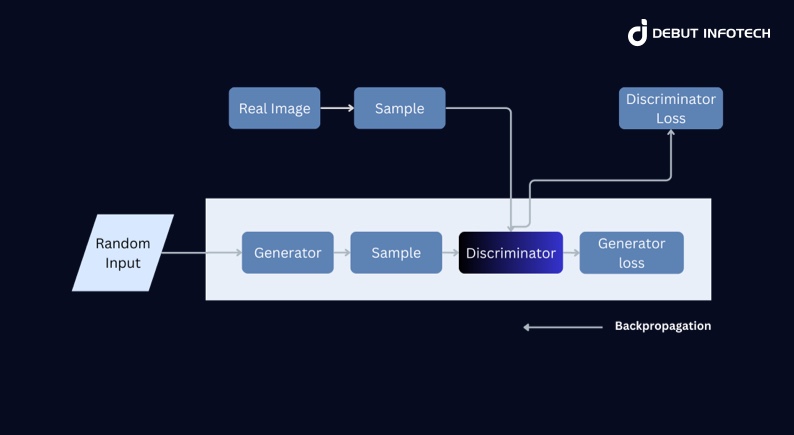
Definition: DCGANs, introduced by Alec Radford et al. in 2015, enhance the Vanilla GAN framework by incorporating deep convolutional neural networks (CNNs).
Features:
- Convolutional Layers: Both the Generator and Discriminator use convolutional layers to process images, improving the quality of the generated images.
- Strided Convolutions: Replace pooling layers with strided convolutions to reduce spatial dimensions, which helps in stabilizing training.
- Batch Normalization: Applied to both networks to standardize the inputs to each layer, thus stabilizing and accelerating the training process.
- Leaky ReLU: Activation function used in the Discriminator for better gradient flow.
Applications:DCGANs are widely used for generating high-quality images and have applications in art, gaming, and image processing.
- Conditional GANs (cGANs)
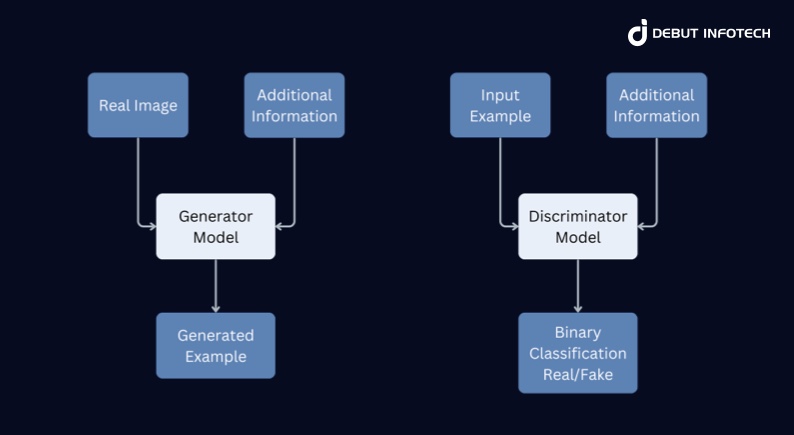
Definition: Conditional GANs extend the basic GAN framework by conditioning both the Generator and the Discriminator on some extra information, such as class labels.
Features:
- Conditional Input: Both the Generator and Discriminator receive additional information (e.g., class labels) as input along with the data.
- Controlled Output: This setup allows for the generation of data samples conditioned on specific attributes, enabling more controlled and specific data generation.
Applications: cGANs are used in scenarios where control over the generated output is needed, such as in image-to-image translation, text-to-image synthesis, and data augmentation for specific classes.
- CycleGANs
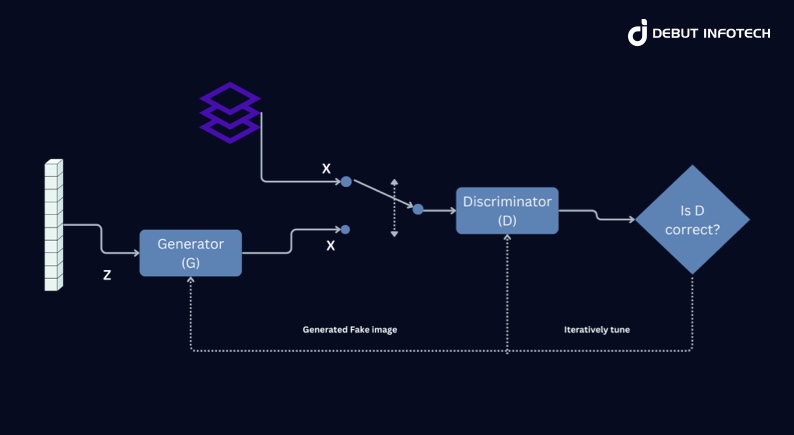
Definition: CycleGANs, introduced by Zhu et al. in 2017, are designed for unpaired image-to-image translation tasks, enabling the conversion of images from one domain to another without requiring paired training data.
Features:
- Cycle Consistency Loss: Ensures that translating an image from one domain to another and back again yields the original image.
- Unpaired Training Data: Capable of learning transformations between domains using unpaired sets of images, which makes it useful for many practical applications where paired data is unavailable.
Applications: CycleGANs are used for style transfer, domain adaptation, and other applications where direct pairings of images across domains are not available, such as converting photos to paintings and vice versa.
- Wasserstein GANs (WGANs)
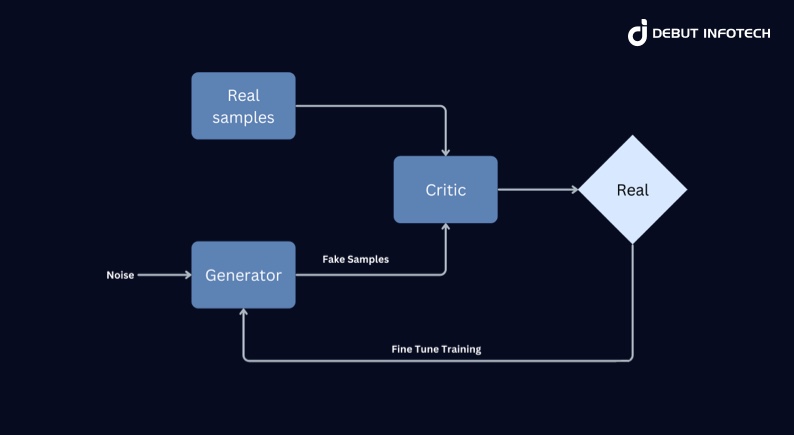
Definition: Wasserstein GANs, proposed by Arjovsky et al. in 2017, improve upon the original GAN framework by using the Wasserstein distance (Earth Mover’s distance) as the loss function, addressing stability issues.
Features:
- Wasserstein Loss: Provides a more stable and meaningful measure of distance between the real and generated data distributions, leading to more stable training.
- Weight Clipping: Used to enforce a Lipschitz constraint, which is necessary for the Wasserstein distance to be valid.
- Gradient Penalty (WGAN-GP): An improvement over weight clipping that stabilizes training by penalizing the gradient norm.
Applications: WGANs are used in applications requiring high-quality image generation and stability, such as art creation, video game design, and complex data simulations.
- StyleGANs
Definition: StyleGANs, developed by NVIDIA in 2018, are known for their ability to generate high-resolution images with fine control over style and content.
Features:
- Style Transfer: The architecture separates high-level attributes (style) from stochastic variations, allowing for control over different aspects of the generated image.
- Progressive Growing: Gradually increases the resolution of both the Generator and Discriminator during training.
- Mapping Network: Introduces a mapping network that converts the input latent vector into an intermediate latent space, providing better control over the generation process.
Applications:StyleGANs are widely used for creating high-resolution images, such as realistic human faces, architectural designs, and detailed textures for virtual environments.
- InfoGANs
Definition:InfoGANs, introduced by Chen et al. in 2016, aim to learn interpretable and disentangled representations within the GAN framework.
Features:
- Mutual Information Maximization: Modifies the GAN architecture to maximize the mutual information between a subset of the latent variables and the generated data.
- Disentangled Representations: Enhances the interpretability of the latent space, allowing for more controlled and meaningful variations in the generated outputs.
Applications:InfoGANs are used in scenarios requiring interpretable and controllable data generation, such as in scientific research, where understanding the underlying factors of generated data is crucial.
- Progressive GANs
Definition:Progressive GANs, proposed by Karras et al. in 2017, generate high-resolution images by progressively increasing the resolution of both the Generator and Discriminator during training.
Features:
- Progressive Training: Starts with low-resolution images and gradually adds layers to increase the resolution, facilitating more stable training.
- Layer-Wise Training: New layers are added progressively, which helps in learning finer details and achieving higher image quality.
Applications:Progressive GANs are particularly effective for generating large, high-resolution images, making them suitable for applications in film production, virtual reality, and detailed image analysis.
- BigGANs
Definition:BigGANs, introduced by Brock et al. in 2018, scale up the GAN architecture to achieve state-of-the-art results on image synthesis tasks.
Features:
- Large-Scale Training: Utilizes larger batch sizes, more layers, and greater computational resources to enhance performance.
- High Fidelity: Achieves significant improvements in image fidelity and diversity.
- Truncated Sampling: Uses a technique to balance diversity and quality in the generated images.
Applications:BigGANs are used for large-scale image generation tasks, such as creating high-quality images for research, entertainment, and commercial applications.
Applications of GANs: Transforming Industries
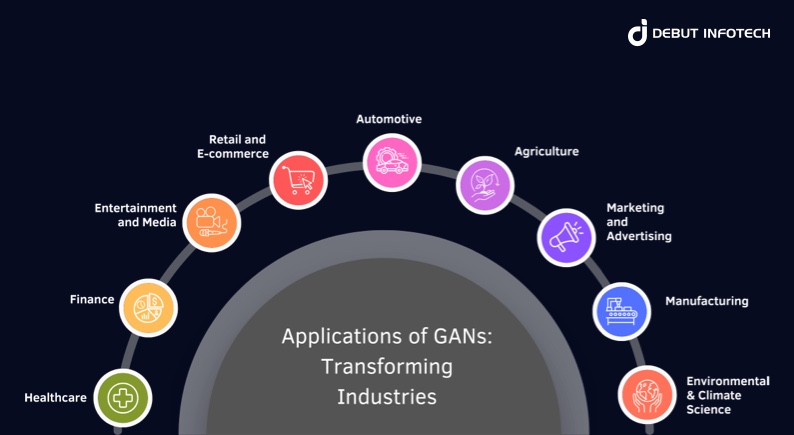
Generative Adversarial Networks (GANs) have revolutionized many industries with their ability to generate realistic synthetic data. Their unique capabilities are transforming sectors ranging from healthcare to entertainment. Here’s a detailed exploration of how GANs are being applied across various industries:
1. Healthcare
- Medical Imaging Enhancement: GANs significantly improve the quality of medical images, such as MRI, CT scans, and X-rays. By enhancing the resolution and reducing noise, GANs help radiologists make more accurate diagnoses.
- Disease Diagnosis and Prediction: GANs can synthesize medical images to train diagnostic models, even when real data is scarce. They can also predict disease progression by analyzing historical patient data and generating possible future scenarios.
- Drug Discovery: GANs accelerate drug discovery by generating new molecular structures with desired properties. This approach reduces the time and cost associated with traditional drug discovery methods.
Example: Research by NVIDIA demonstrated that GANs could generate high-quality synthetic mammograms, which can be used to train AI models for breast cancer detection without exposing patients to additional radiation.
2. Finance
- Fraud Detection: GANs generate synthetic fraud scenarios to train robust fraud detection systems. By simulating various types of fraudulent activity, financial institutions can enhance their systems to detect and prevent fraud more effectively.
- Market Simulation: GANs simulate market conditions, helping in stress-testing trading algorithms and financial models. These simulations provide a risk-free environment to evaluate the performance of investment strategies under different market scenarios.
- Risk Management: Financial institutions use GANs to predict potential market risks and develop strategies to mitigate them. GANs help in modeling rare events and tail risks, providing a more comprehensive understanding of market dynamics.
Example: J.P. Morgan Chase has used GANs to create realistic synthetic datasets that help improve the robustness of their fraud detection and risk management systems.
3. Entertainment and Media
- Image and Video Generation: GANs generate highly realistic images and videos for use in films, video games, and virtual reality experiences. They can create lifelike characters, backgrounds, and special effects, significantly reducing production costs and time.
- Deepfakes: While controversial, deepfake technology leverages GANs to create hyper-realistic videos of people. This technology has potential applications in entertainment, such as creating digital avatars and resurrecting deceased actors for new roles.
- Content Creation: GANs assist in creating content for marketing and advertising. They generate product images, promotional videos, and other marketing materials, allowing for personalized and engaging content tailored to specific audiences.
Example: Pixar and other animation studios use GANs to generate realistic textures and environments, enhancing the visual quality of animated films and reducing manual labor.
4. Retail and E-commerce
- Product Design: GANs help designers create new product designs by generating realistic prototypes. This technology enables rapid iteration and exploration of different design possibilities.
- Virtual Try-Ons: GANs enable virtual try-on applications, allowing customers to see how clothes, accessories, or makeup would look on them. This enhances the online shopping experience and reduces return rates.
- Inventory Management: GANs predict demand for products, helping retailers manage their inventory more efficiently. By analyzing sales data and generating synthetic future scenarios, GANs help optimize stock levels and reduce overstocking.
Example: Zalando, a fashion e-commerce platform, uses GANs to provide customers with virtual fitting rooms, allowing them to try on clothes virtually before making a purchase.
5. Automotive
- Autonomous Vehicles: GANs generate synthetic driving data to train autonomous vehicle systems. This data includes various driving scenarios, weather conditions, and road types, helping improve the robustness and safety of self-driving cars.
- Design and Manufacturing: GANs aid in the design and manufacturing of vehicles by generating innovative design concepts and optimizing manufacturing processes. They help in creating more efficient and aesthetically pleasing vehicle designs.
- Traffic Simulation: GANs simulate traffic patterns and road conditions, helping urban planners design better traffic management systems and improve infrastructure planning.
Example: Waymo, a subsidiary of Alphabet, uses GANs to generate realistic driving scenarios to train and test their autonomous vehicle algorithms, ensuring they can handle a wide range of real-world situations.
6. Agriculture
- Crop Monitoring: GANs analyze satellite images to monitor crop health and predict yields. They help in identifying diseases, pests, and nutrient deficiencies, enabling timely intervention.
- Precision Agriculture: GANs generate detailed soil and weather models to optimize planting schedules and irrigation systems. They help farmers make data-driven decisions to maximize crop yields and minimize resource usage.
- Supply Chain Optimization: GANs predict demand for agricultural products, helping in optimizing supply chains and reducing food waste. They generate synthetic scenarios to test the resilience of supply chains under different conditions.
Example: John Deere uses GANs to analyze drone imagery of crops, providing farmers with detailed insights into crop health and helping them manage their fields more effectively.
7. Marketing and Advertising
- Personalized Advertising: GANs create personalized advertisements tailored to individual preferences. By analyzing user data, GANs generate targeted ad content that resonates more with potential customers.
- Product Visualization: GANs generate high-quality product images and videos for marketing campaigns. They create realistic visual content that enhances product appeal and drives customer engagement.
- Market Research: GANs synthesize consumer data to simulate market responses to new products. This helps companies refine their marketing strategies and product designs before launching them in the market.
Example: Nike uses GANs to generate personalized marketing content for their customers, creating more engaging and relevant advertising campaigns.
8. Manufacturing
- Quality Control: GANs generate synthetic defect data to train quality control systems. These systems can detect defects more accurately by learning from a diverse set of synthetic and real defect examples.
- Predictive Maintenance: GANs predict equipment failures by analyzing operational data and generating synthetic failure scenarios. This helps in scheduling maintenance activities before breakdowns occur, reducing downtime and costs.
- Process Optimization: GANs simulate different manufacturing processes to identify the most efficient methods. They help in optimizing production lines and improving overall manufacturing efficiency.
Example: Siemens uses GANs to enhance their predictive maintenance systems, ensuring their industrial equipment operates smoothly and efficiently.
9. Environmental and Climate Science
- Climate Modeling: GANs simulate climate change scenarios to predict future climate patterns. They help researchers understand the potential impacts of climate change and develop strategies to mitigate its effects.
- Environmental Monitoring: GANs analyze satellite imagery to monitor environmental changes, such as deforestation, urbanization, and glacier melting. They provide insights into the health of ecosystems and natural resources.
- Disaster Management: GANs predict natural disasters, such as hurricanes, floods, and wildfires, by generating synthetic scenarios. This helps in planning and implementing effective disaster response strategies.
Example: The European Space Agency (ESA) uses GANs to analyze satellite images for monitoring environmental changes and assessing the impact of human activities on the planet.
The Rising Future of Generative Adversarial Networks (GANs)
Generative Adversarial Networks (GANs) have already demonstrated their vast potential across various fields, from image and video synthesis to natural language processing and drug discovery. As advancements continue, GANs are poised to find even more groundbreaking applications. Here’s a look at some promising future applications and research trends.
Transformative Applications of GANs Across Industries
- Immersive Virtual and Augmented Reality
GANs can significantly enhance virtual reality (VR) and augmented reality (AR) by creating highly realistic 3D models and environments. This will lead to more immersive experiences in gaming, virtual tours, architectural visualization, and beyond. GAN-generated models will provide users with lifelike interactions and detailed virtual surroundings, enriching the overall experience.
- Innovative Fashion and Product Design
In the fashion and design sectors, GANs can generate new and unique patterns, styles, and products. This innovation can streamline the creative process, enabling designers to produce personalized clothing, accessories, and home decor tailored to individual preferences. The integration of GANs will push the boundaries of creativity and customization in design.
- Advanced Healthcare Solutions
GANs have the potential to revolutionize healthcare by enhancing medical imaging, improving diagnostic accuracy, and aiding in the discovery of new drugs. They can generate high-quality synthetic medical images, simulate disease progression, and create novel molecules for therapeutic use. These advancements will lead to more precise diagnostics and innovative treatments.
- Enhanced Robotics Training and Development
In robotics, GANs can generate synthetic data to train robots more effectively, improving their performance in real-world environments. GANs can also aid in developing new robot behaviors and designs, allowing for more adaptive and efficient robotic systems capable of tackling complex tasks.
- Revolutionizing Marketing and Advertising
GANs can produce highly realistic images and videos of products, enabling more engaging and personalized marketing campaigns. By generating content tailored to individual consumer preferences, businesses can create more effective advertisements that resonate with their target audiences, thereby enhancing customer engagement and conversion rates.
- Creative Arts and Music
The arts and music industries can benefit significantly from GANs, which can synthesize new art styles and music compositions. This capability allows artists and musicians to explore innovative creative processes and produce personalized content based on individual tastes, pushing the boundaries of artistic expression.
- Agricultural Innovations
In agriculture, GANs can help optimize crop yields and improve pest control by analyzing and synthesizing agricultural data. They can generate realistic simulations of crop growth under various conditions, aiding farmers in making informed decisions about planting, irrigation, and pest management.
- Environmental and Climate Research
GANs can contribute to environmental science by modeling climate change scenarios and predicting environmental impacts. They can generate synthetic data to simulate various ecological conditions, helping researchers develop strategies for conservation and sustainable development.
- Financial Modeling and Risk Assessment
GANs are already making strides in the finance industry by enhancing fraud detection and financial forecasting. In the future, they will further improve algorithmic trading, personalized financial services, and risk assessment models by generating realistic market scenarios and providing deeper insights into financial data.
- Advanced Manufacturing and Supply Chain Optimization
Manufacturing processes can benefit from GANs through improved quality control and predictive maintenance. GANs can simulate production line scenarios, optimize supply chains, and design innovative materials, leading to more efficient and cost-effective manufacturing operations.
Emerging Research Directions in GANs
- Enhancing Training Stability
Improving the stability of GAN training remains a critical area of research. New techniques such as spectral normalization, weight normalization, and self-attention mechanisms are being developed to address issues like mode collapse and training instability, leading to more robust and reliable models.
- Mitigating Bias
Addressing bias in GANs is essential for ensuring fair and accurate outputs. Researchers are exploring fairness constraints, adversarial debiasing, and other methods to reduce bias and enhance the generality of GAN-generated data.
- Conditional Generation Innovations
Innovations in conditional generation are expanding the versatility of GANs. Techniques like auxiliary classifiers and label smoothing are being refined to improve the accuracy and diversity of outputs based on additional inputs such as class labels or attributes.
- Achieving High-Fidelity Outputs
High-fidelity generation is a key goal for GAN research. Techniques such as progressive growth and attention mechanisms are being utilized to produce highly realistic images and videos, pushing the boundaries of what GANs can achieve in terms of quality and detail.
- Expanding to New Domains
Researchers are continually exploring new applications for GANs, including music generation, text-to-image synthesis, and speech synthesis. These efforts are opening up new possibilities for creative and technical advancements across various fields.
- Interpreting GAN Outputs
Understanding and interpreting GAN-generated data is crucial for refining models and improving transparency. Visualization methods and disentanglement techniques are being developed to analyze the complex patterns generated by GANs, providing deeper insights into their functioning and outputs.
Ethical Considerations and Responsible Development of GAN
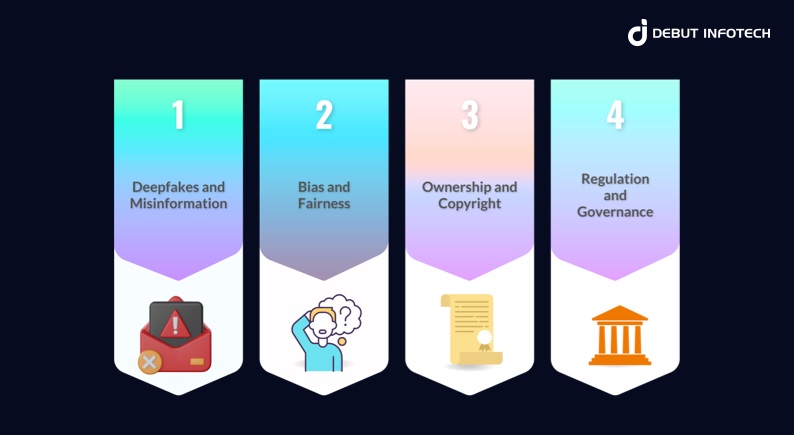
While GANs hold immense potential, their capabilities also raise ethical concerns. Here are some key considerations for responsible development:
- Deepfakes and Misinformation
GANs can be used to create highly realistic deepfakes of videos or audio recordings, potentially leading to the spread of misinformation and manipulation. Mitigating this risk requires developing detection techniques for deepfakes and fostering public awareness about these synthetic media.
- Bias and Fairness
As with any AI system, GANs are susceptible to inheriting biases present in the data they are trained on. This can lead to discriminatory outputs. Ensuring fairness and inclusivity in GAN development requires diverse training datasets and careful evaluation of generated content.
- Ownership and Copyright
With GANs generating creative content like images or music, questions arise regarding intellectual property ownership. Establishing clear guidelines for copyright and ownership of GAN-generated content is essential to encourage responsible use and protect the rights of creators.
- Regulation and Governance
As GAN technology advances, regulatory frameworks might be needed to ensure its responsible development and deployment. This could involve establishing ethical guidelines for training and use, promoting transparency, and mitigating potential misuse.
Addressing these ethical considerations is crucial for ensuring that GANs are used for good and contribute positively to society. Open discussions, collaboration between researchers, developers, and policymakers, and a commitment to responsible AI development are essential for a future where GANs can unlock their full potential for the benefit of humanity.
Conclusion
Generative Adversarial Networks (GANs) represent a significant leap forward in the realm of artificial intelligence, offering transformative applications across a wide range of industries. From enhancing medical imaging and revolutionizing the fashion industry to improving financial modeling and advancing environmental research, GANs are pushing the boundaries of what is possible with deep learning. However, their potential comes with challenges that require careful attention, such as training stability, bias mitigation, and ethical considerations.
As we look to the future, the role of specialized AI development companies like Debut Infotech becomes increasingly crucial. Debut Infotech, a leader in Generative AI development services, is at the forefront of creating innovative solutions that harness the power of GAN networks. Our expertise spans from developing advanced healthcare applications to optimizing manufacturing processes and beyond. We are committed to delivering comprehensive and customized AI solutions that address specific business needs while ensuring ethical and responsible AI practices.
By partnering with Debut Infotech, businesses can leverage cutting-edge GAN technology, including generative neural networks and adversarial neural networks, to drive innovation, enhance efficiency, and unlock new opportunities. As generative adversarial networks continue to evolve, Debut Infotech remains dedicated to pioneering advancements in AI, helping clients navigate the complexities of Generative AI development and achieve transformative results.
Contact us today to explore how our deep learning solutions, including GAN generative adversarial networks, can empower your business to stay ahead in an ever-changing technological landscape.
Talk With Our Expert
USA
2102 Linden LN, Palatine, IL 60067
+1-708-515-4004
info@debutinfotech.com
UK
Debut Infotech Pvt Ltd
7 Pound Close, Yarnton, Oxfordshire, OX51QG
+44-770-304-0079
info@debutinfotech.com
Canada
Debut Infotech Pvt Ltd
326 Parkvale Drive, Kitchener, ON N2R1Y7
+1-708-515-4004
info@debutinfotech.com
INDIA
Debut Infotech Pvt Ltd
Sector 101-A, Plot No: I-42, IT City Rd, JLPL Industrial Area, Mohali, PB 140306
9888402396
info@debutinfotech.com




Leave a Comment